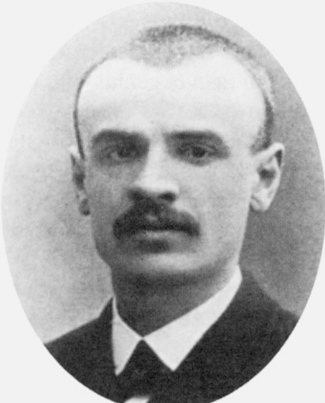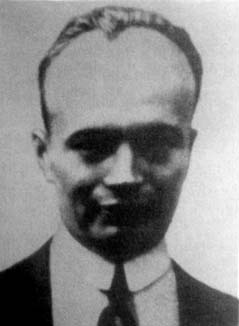<Back to Index>
- Mathematician René - Louis Baire, 1874
- Mathematician Juliusz Paweł Schauder, 1899
PAGE SPONSOR

René - Louis Baire (21 January 1874 – 5 July 1932) was a French mathematician most famous for his Baire category theorem, which helped to generalize and prove future theorems. His theory was published originally in his dissertation Sur les fonctions de variable réelles ("On the Functions of Real Variables") in 1899.
The son of a tailor, Baire was one of three children from a poor working class family in Paris. He started his studies when he entered the Lycée Lakanal through the use of a scholarship. In 1890, Baire completed his advanced classes and entered the special mathematics section of the Lycée Henri IV. While there, he prepared for and passed the entrance examination for the École Normale Supérieure and the École Polytechnique. He decided to attend the École Normale Supérieure in 1891. After receiving his three year degree, Baire proceeded toward his aggregation. He did better than all the other students on the writing portion of the test but he did not pass the oral examination due to a lack of explanation and clarity in his lecture. After retaking the aggregation and passing, he was assigned to teach at the Lycée in Bar-le-Duc. While there, Baire researched the concept of limits and discontinuity for his doctorate. He presented his thesis on March 24, 1899 and was awarded his doctorate. He continued to teach in lycées around France but was not happy teaching lower level mathematics. In 1901 Baire was appointed to the University of Montpellier as a "Maître de conférences". In 1904 he was awarded a Peccot Foundation Fellowship to spend a semester in a university and develop his skills as a professor. Baire chose to attend the Collège de France where he lectured on the subject of analysis. He was appointed to a university post in 1905 when he joined the Faculty of Science at Dijon. In 1907 he was promoted to Professor of Analysis at Dijon where he continued his research in analysis. He retired from Dijon in 1925 and spent his last years living in multiple hotels that he could afford with his meager pension.
Since he was young, Baire always had "delicate" health. He had developed problems with his esophagus before he attended school and he would occasionally experience severe attacks of agoraphobia. From time to time, his health would prevent him from working or studying. The bad spells became more frequent, immobilizing him for long periods of time. Over time, he had developed a kind of psychological disorder which made him unable to undertake work which required long periods of concentration. At times this would make his ability to research mathematics impossible. Between 1909 and 1914 this problem continually plagued him and his teaching duties became more and more difficult. He was given a leave of absence from Dijon due to all these breakdowns.
Baire's skill in mathematical analysis led him to study with other major names in analysis such as Vito Volterra and Lebesgue. In his dissertation Sur les fonctions de variable réelles ("On the Functions of Real Variables"), Baire studied a combination of set theory and analysis topics to arrive at the Baire Category Theorem and define the nowhere dense set. He then used these topics to prove the theorems of those he studied with and further the understanding of continuity. Among Baire’s other most important works are Théorie des nombres irrationels, des limites et de la continuité (Theory of Irrational Numbers, Limits, and Continuity) published in 1905 and both volumes of Leçons sur les théories générales de l’analyse (Lessons on the General Theory of Analysis) published in 1907 – 08.

Juliusz Paweł Schauder (September 21, 1899, Lemberg, Austria - Hungary (now Lviv, Ukraine) – September 1943, Lemberg, Occupied Poland) was a Polish mathematician of Jewish origin, known for his work in functional analysis, partial differential equation and mathematical physics.
Born on September 21, 1899 in Lemberg, he had to fight in World War I right after his graduation from school. He was captured and imprisoned in Italy. He entered the university in Lwów in 1919 and received his doctorate in 1923. He got no appointment at the university and continued his research while working as teacher at a secondary school. Due to his outstanding results, he obtained a scholarship in 1932 that allowed him to spend several years in Leipzig and, especially, Paris. In Paris he started a very successful collaboration with Jean Leray. Around 1935 Schauder obtained the position of a senior assistant in the University of Lwów.
Schauder was Jewish, and after the invasion of German troops in Lwów it was impossible for him to continue his work. In his letters to Swiss mathematicians, he wrote that he had important new results, but no paper to write them down. He was executed by the Gestapo, probably in October 1943.
Most of his mathematical work belongs to the field of functional analysis, being part of a large Polish group of mathematicians, namely the Lwów School of Mathematics. They were pioneers in this area with wide applications in all parts of modern analysis. Schauder is best known for the Schauder fixed point theorem which is a major tool to prove the existence of solutions in various problems, the Schauder bases (a generalization of an orthonormal basis from Hilbert spaces to Banach spaces), and the Leray − Schauder principle, a way to establish solutions of partial differential equations from a priori estimates.